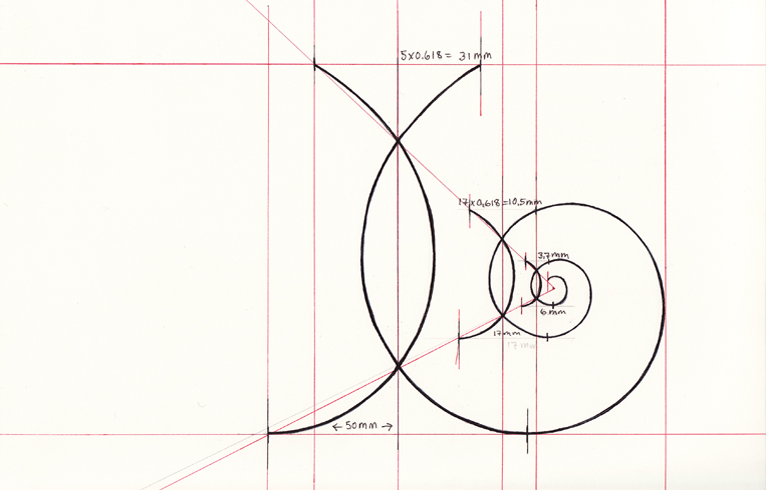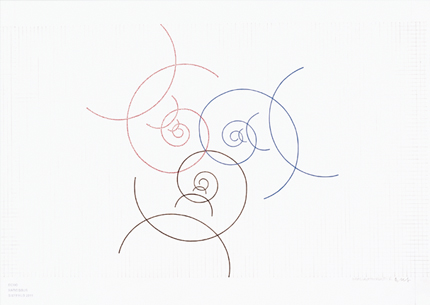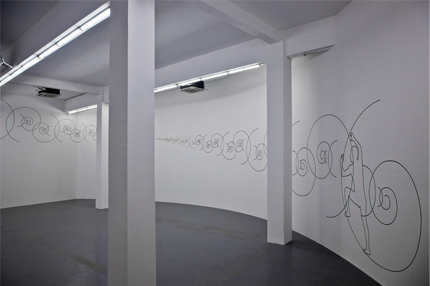METAPHYSICAL FORMS: WU SHANZHUAN AND INGA SVALA THORSDOTTIR’S “Kuò Xuán”
| February 14, 2012 | Post In LEAP 12

DOMAIN
WHEN IN THE summer of 2010 Gao Shiming invited Wu Shanzhuan and Inga Svala Thorsdottir to design the logo for the China Academy of Arts’ then newly-established School of Inter Media Art, his hope was that the logo would have a narrative quality, and not the minimalist style popular today— something similar to more traditional insignia like the national emblem, or Wu’s design for Today No Water.
This winter in Iceland, as Wu Shanzhuan sat facing the sketches for his “perfect brackets,” Thorsdottir came over, took a look, and said, “Why don’t we add a spiral here?” Wu said, “Aha! Inga, that’s it! We can continue to cut into it like this…” And this is how “kuò xuán” came into being. According to Wu, this proves that “perfect brackets” are fertile, since the perfection of a thing often signifes its inability to continue to reproduce.
Wu Shanzhuan is an expert on logos, and he has devoted himself to the creation of various kinds of symbols and forms for a long time. His creations call to mind the origins of various kinds of commonly used symbols, such as Leibniz’s notation using an elongated S from the Latin summa (Latin for “sum” or “total”) to represent the indefinite integral in integral calculus.
Once this sort of design becomes systematized, it seems to take on the somewhat theological work of laying the foundations for the creation of the world. And in essence, design is an extremely spiritual undertaking. If we were to trace this back in time, it would go back to Wu Shanzhuan’s early 1980s series of “fake characters” and “red characters.” As the ancient Chinese story goes, new Chinese characters were formed from millet that rained from the sky and the wailing of ghosts in the night. This kind of absurd creation story is also the biggest difference between Wu and other major artists who have worked with made-up characters. This is best embodied by Wu’s steadfast vow to be the standard-bearer for incorrect Chinese characters, a mentality geared towards the establishment of an ideology, towards the establishment of a worldview for a private world. From this we can consider anew the idea of a genuine private world. This is how such everyday speech is elevated to the level of theological notion.
It was from a completely different path that Inga Svala Thorsdottir arrived in this dimension and came to meet Wu Shanzhuan. To this day, Iceland maintains its ancient European language, and the creation story and epic ambience of many Nordic myths coalesce in Thorsdottir’s early work. Some of the tales are vague and even obscure, yet profound. At the same time, from the time of Ancient Greece no lack of Europeans began to have a frm belief in science and truth; the result was a sort of socialized science fction. She turned ready-made objects into dust in her work titled Thor’s Daughter’s Pulverization Service. And in the open country of Iceland, at a specifc latitude and longitude, she set up a town, BORG, from her imagination. The set-up was extremely elaborate— exquisitely executed right down to every detail in order to bring the fantasy to life. She worked out the city’s every detail to perfection, and consequently BORG became a utopia, the fabled Peach Blossom Spring and Moore’s Utopia all in one, for one simple reason: someone who has been expelled from utopia (the artist) tries to reconstruct utopia.
Apart from the embodiment of Thorsdottir’s precision and mythology, the “kuò xuán” exhibition is also an extension of Wu Shanzhuan’s “Formulation” method, which has a tendency to regard formulas as a kind of literature so as to arrive at an aesthetic similar to poetry yet markedly different. Wu’s early works already betray a tendency to solve problems using formulas or “fake formulas.” When he was still living and working in the Zhoushan Archipelago of his birth, Wu’s big-character political posters, red fags, red stamps and other paraphernalia bearing the characteristic red of the government or the revolution all had set proportions: 75% red, 20% black, 5% white. Later on, he dealt with the red of Europe’s capitalism in various ways, such as his How to Steal Thousand Reds from Supermarket. In 2010 for Long March Space’s “Ho Chi Minh Trail Project,” he set up a horseshoe-shaped installation, fanked on either side by the sentence “VIOLENCE IS THE ULTIMATE MATERIALIZATION OF UNDERSTANDING.” My response to this witticism as well as to Wu’s work is that the formula is the supreme method of reconciliation. Formulas are at large; they transcend personal experience, identity politics, and the small limits on cultural resources. Historically, Newton and Leibniz became irreconcilable as they vied intensely to be the creator of calculus. Now that they are dead, however, in any advanced mathematics textbook you can fnd the phrase “formulas of Newton-Leibniz”— their names immortalized as one. This is a victory for formulas, and with the total collapse of the study of aesthetics today, often it is only in mathematics and physics that we can enjoy this sense of aesthetics, the type of beauty and reconciliation associated with truth (reason).

WITHOUT EDGE
THE INTERTWINING OF two individuals forms the heart of the exhibition hall, their partnership fnely woven into every central space and the periphery. This vaguely calls to mind the individual pencil strokes of the grid pattern that always forms the backdrop of Thorsdottir’s works; correspondingly, the room for the exhibition of Wu Shanzhuan’s earliest large-script posters is literally an empty space.
At the time when Wu and Thorsdottir happened to meet by chance, I heard that she had had a wonderful idea for the snow shovel in Marcel Duchamp’s In Advance of the Broken Arm: she would secretly take the snow shovel, go out into a feld, and put it to use again, thereby managing to allow it to merge once again with the other snow shovels. Although this was completely insane, her intentions were not bad; she called this kind of behavior “appreciation.” This way of working out the composition of her works fnally culminated in the act of An Appreciation , with Marcel Duchamp’s urinal Fountain becoming the object of appreciation. In order to avoid a feminist interpretation of the work, Wu Shanzhuan participated as well, urinating in Duchamp’s urinal. At that time, Wu was also in the process of pursuing his concept of “Wu’s Thing.” Building from this notion, their frst major collaboration Thing’s Right(s) emerged. Compared to those of the endless array of other spoofs of Duchamp’s work, the rationale behind Wu and Thorsdottir’s approach was actually extraordinarily reasonable: to turn a work of art back into an object is to exalt the return of an object to its original condition, thereby rescuing it from this crime perpetrated against objects.
In 1995, they collaborated on a reworking of the Universal Declaration of Human Rights that became Thing’s Right(s) .Substituting the character for “thing” for the character for “human” throughout the document, they accomplished a kind of abstraction and extension. This is the kind of situation that frequently arises in Wu and Thorsdottir’s work: insight, then abstraction, then projection, then superimposi tion, to the point that it reaches a grand scale. They are able to continuously reproduce, overlay, and augment what they produce, dealing with the real results of their efforts and continuing to raise their works to a higher level. A continuous amplification of the self, what emerges is a second phase that reaches an even higher level than the frst. But compared with Private Language , it still is by no means “psychologistic.” Consequently, through the endless continuation of abortive efforts, the way things are today is diffcult to formulate and relate to. In this sense, the beginning and end of “kuò xuán” have a limitlessness that completely corresponds to the methodology of Wu and Thorsdottir’s work.
Apart from this, this kind of limitlessness is also a state of mind. This state of mind inspires Wu to maintain exceptional composure toward the expression of all of human knowledge. Tourist information , with travelers’ information and luggage, takes place during the limitlessness of the end and the beginning of our limited lives. In 1992’s Tourist Information—Alphabetical Aphorisms, there is the following sentence:
Already
When Wu was born, other persons had already been born. Wu will leave this world after other persons have already left.
ROTATION/RECOVERY
IN TOURIST INFORMATION: ALPHABETICAL APHORISMS, Wu Shanzhuan wrote, “Wu’s labouring work is a period of Sisyphus because his own concept does not appear within his action. Therefore Wu sometimes gets holiday, but Sisyphus does not.” [sic] In a draft he made that same year, he realized that these two people had “no way to converse” while they worked: “Here is no dialogue between Sisyphus and Narcissus.” But today, he has introduced “Echo” the “female neighbor” to his long-contemplated world of Narcissus and Sisyphus. Wu says, “As far as the scriptures go, we often wrongly think that we are powerless. But now I have come up with a solution: create a new trinity.”
The implications layered over the subject perhaps add an element that brings about a new form of interaction. And to their way of thinking, this is a way of opening up the self. In terms of the relationship of theirs to other ideologies, Wu’s response is that the ideologies, even if opposing, are neighbors. Wittgenstein said: “Surely no one is going to believe that brackets have an independent meaning.” Wu and Thorsdottir’s “perfect bracket” formula unwittingly produced a counter-example. As for other neighbors as well as the changes in the world toward the self, their attitude toward them is this: “God is other people.” Even though this is possibly the answer to Sartre’s “Hell is other people,” it also treads lightly on the edge of Levinas’ laboriously demonstrated argument: other people and God have the same external transcendent subjectivity; similarly, the work “So Birds Are, before They Are Peaceful” unwittingly approaches the edge of Sartre’s “existence before essence.” The “neighbors” of their ideology are all each other’s “tourists.”
Three years ago, Wu Shanzhuan took up swimming because of a bone spur in one of his vertebrae. His body became much healthier and stronger, and the spur went away, while Thorsdottir also began a daily swimming regimen. The reason I bring up this anecdote is that rotation and recovery are both important movements and concepts in swimming, and today the pair continues to use precisely this way of life in forming its relationship with the world. What curator Gao Shiming and the two artists have created in this exhibition is also a criticism outside of the show. There is an immediacy to this type of exchange. They critiqued and judged to the extent that the critiquing had already happened even before the exhibition, and it continued to reverberate after the show was over. It was like a discussion between friends, or like the group discussions often depicted in traditional art. But it did not start with business meetings to discuss the show, because when the curtain went down on the exhibition, the dialogue did not end— it just allowed the exhibition to serve as the platform for the next exchange.

SISYPHUS
BORIS GROYS ONCE wrote that avant-garde work, such as the images created by Kandinsky, Malevich and others employing the reduction method that became widespread, as well as weak transcendental images— as distinguished from the strong images of more traditional paintings and mass media— often precisely because of their reductive quality became an extremely strong image in contrast. The reason is that, as Wu and Thorsdottir see it, Malevich’s effectiveness was not in reduction, but addition. Just as the approach in An Appreciation represents a set of complex numbers, what is meaningful to Wu and Thorsdottir about the addition approach is not the black boxes but rather the white on white, as well as that sentence, “My white is more white than white,” repeated over and over, completely in white. This sentence is actually no different from the words of mathematician David Hilbert: “We must know. We will know!” That is, belief in belief.
In the exhibition hall for “kuò xuán,” a light but densely laid grid pattern like scaffolding allows each of the images to command its own place and yet maintain a subtle link to the others, forming a unifed whole. The effect strongly takes after the painstaking attention to detail that Thorsdottir has always venerated in her work. To the outside observer, it almost seems inordinately elaborate, but belief is at work here. Obviously, however excessive the design scheme may be, it must have a solid foundation. Wu has mentioned the infuence of Thorsdottir’s technique on his work several times, saying, “She is obsessed with the possibility of the necessary existence of precision of approach.”
If you were to say that discrete territories and bodies still exist, to this Wu Shanzhuan would usually say that the self-refective guile and cleverness of Asians, and even their negative intentions, along with Europeans’ precision to the point of ruthlessness and their eminent rationality, seem more like steadfast beliefs than anything: “If there are still beliefs today, then they must be applied one on top of another.” From Thorsdottir’s precisely executed “Pulverization,” we can see that all objects are eventually ground down into powder through repetitive actions over a long period of time. Through the careful gathering, sorting, bottling and labeling of these things, the idea that all living things eventually return to dust emerges. This idea does not belong to any meditative mindset here; it has nothing to do with the diffcult task of meditation. Camus believed that Sisyphus was happy each time he labored futilely up the hill and came back down. But the title of Thorsdottir’s work tells of a different type of contentment: “The same attitude toward different things.”
Consequently, in the exhibition hall, the part you can see is not a fnished result, but more like a prelude— a metaphysical projection. Too many exhibitions are a completion ritual to the extent that they have become a kind of memorial ceremony. This exhibition, however, is a groundbreaking ceremony.
— Somewhere not far from the hillside where Sisyphus labored must be Narcissus’ pool— but where? What does Narcissus do after dark? In Sisyphus’ daily fruitless labor, if he were to suddenly push the boulder over the hill, would this be a creation?
— Creation lies in recovery, limitlessness lies in rotation. This way we don’t necessarily have to turn over…

